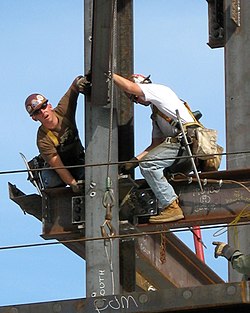Authority having jurisdiction
See also: Planning permission
In construction, the authority having jurisdiction (AHJ) is the governmental agency or sub-agency that regulates the construction process. In most cases, this is the municipality where the building is located. However, construction performed for supra-municipal authorities are usually regulated directly by the owning authority, which becomes the AHJ.
Before the foundation can be dug, contractors are typically required to verify and have existing utility lines marked, either by the utilities themselves or through a company specializing in such services. This lessens the likelihood of damage to the existing electrical, water, sewage, phone, and cable facilities, which could cause outages and potentially hazardous situations. During the construction of a building, the municipal building inspector inspects the building periodically to ensure that the construction adheres to the approved plans and the local building code. Once construction is complete and a final inspection has been passed, anoccupancy permit may be issued.
An operating building must remain in compliance with the fire code. The fire code is enforced by the local fire department or a municipal code enforcement office.
Changes made to a building that affect safety, including its use, expansion, structural integrity, and fire protection items, usually require approval of the AHJ for review concerning the building code.
Industry characteristics[edit]
In the United States, the industry in 2014 has around $960 billion in annual revenue according to statistics tracked by the Census Bureau, of which $680 billion is private (split evenly between residential and nonresidential) and the remainder is government.[24] As of 2005, there were about 667,000 firms employing 1 million contractors (200,000 general contractors, 38,000 heavy, and 432,000 specialty); the average contractor employed fewer than 10 employees.[25] As a whole, the industry employed an estimated 5.8 million as of April 2013, with a 13.2% unemployment rate.[26] In the United States, approximately 828,000 women were employed in the construction industry as of 2011.[27]
Careers
There are many routes to the different careers within the construction industry. These three main tiers are based on educational background and training, which vary by country:
- Unskilled and semi-skilled – General site labor with little or no construction qualifications.
- Skilled – Tradesmen who've served apprenticeships, typically in labor unions, and on-site managers who possess extensive knowledge and experience in their craft or profession.
- Technical and management – Personnel with the greatest educational qualifications, usually graduate degrees, trained to design, manage and instruct the construction process.
Skilled occupations include carpenters, electricians, plumbers, ironworkers, masons, and many other manual crafts, as well as those involved in project management. In the UK these require further education qualifications, often in vocational subject areas. These qualifications are either obtained directly after the completion of compulsory education or through "on the job" apprenticeship training.[28] In the UK, 8500 construction-related apprenticeships were commenced in 2007.[29]
Technical and specialized occupations require more training as a greater technical knowledge is required. These professions also hold more legal responsibility. A short list of the main careers with an outline of the educational requirements are given below:
- Architect – Typically holds 1, undergraduate 3 year degree in architecture + 1, post-graduate 2 year degree (DipArch or BArch) in architecture plus 24 months experience within the industry. To use the title "architect" the individual must be registered on the Architects Registration Board register of Architects.
- Civil engineer – Typically holds a degree in a related subject. The Chartered Engineer qualification is controlled by the Engineering Council, and is often achieved through membership of the Institution of Civil Engineers. A new university graduate must hold a master's degree to become chartered; persons with bachelor's degrees may become an Incorporated Engineer.
- Building services engineer – Often referred to as an "M&E Engineer" typically holds a degree in mechanical or electrical engineering. Chartered Engineer status is governed by the Engineering Council, mainly through the Chartered Institution of Building Services Engineers.
- Project manager – Typically holds a 4-year or greater higher education qualification, but are often also qualified in another field such as architecture, civil engineering or quantity surveying.
- Structural engineer – Typically holds a bachelor's or master's degree in structural engineering. A P.ENG is required from the Professional Engineers Ontario (Canada). New university graduates must hold a master's degree to gain chartered status from the Engineering Council, mainly through the Institution of Structural Engineers (UK).
- Quantity surveyor – Typically holds a bachelor's degree in quantity surveying. Chartered status is gained from the Royal Institution of Chartered Surveyors.
- Civil estimators are professionals who typically have a background in civil engineering, construction project management, or construction supervision.
In 2010 a salary survey revealed the differences in remuneration between different roles, sectors and locations in the construction and built environment industry.[30] The results showed that areas of particularly strong growth in the construction industry, such as the Middle East, yield higher average salaries than in the UK for example. The average earning for a professional in the construction industry in the Middle East, across all sectors, job types and levels of experience, is £42,090, compared to £26,719 in the UK.[31] This trend is not necessarily due to the fact that more affluent roles are available, however, as architects with 14 or more years experience working in the Middle East earn on average £43,389 per annum, compared to £40,000 in the UK.[31] Some construction workers in the US/Canada have made more than $100,000 annually, depending on their trade.[32]
Safety
See also: Construction site safety
Construction is one of the most dangerous occupations in the world, incurring more occupational fatalities than any other sector in both the United States and in the European Union.[33][34] In 2009, the fatal occupational injury rate among construction workers in the United States was nearly three times that for all workers.[33] Falls are one of the most common causes of fatal and non-fatal injuries among construction workers.[33] Proper safety equipment such as harnesses and guardrails and procedures such as securing ladders and inspecting scaffolding can curtail the risk of occupational injuries in the construction industry.[35] Other major causes of fatalities in the construction industry include electrocution, transportation accidents, and trench cave-ins.[36]
Other safety risks for workers in construction include hearing loss due to high noise exposure, musculoskeletal injury, chemical exposure, and high levels of stress.[27]
History[edit]
Main article: History of construction
See also: History of architecture
The first huts and shelters were constructed by hand or with simple tools. As cities grew during the Bronze Age, a class of professional craftsmen, like bricklayers and carpenters, appeared. Occasionally, slaves were used for construction work. In the Middle Ages, these were organized into guilds. In the 19th century, steam-powered machinery appeared, and later diesel- and electric powered vehicles such as cranes, excavators and bulldozers.
Fast-track construction has been increasingly popular in the 21st century. Some estimates suggest that 40% of construction projects are now fast-track construction.[37]
Construction phases
- Vision/fantasy/idea - a concept never intended to be built, may be an aesthetic or structural design exercise
- Proposed - a building concept that is under review by the building owner and by government
- Approved - a building concept that will be constructed in the near future. If the proposed building is not approved then the proposal may be amended and resubmitted, or it may be deferred or cancelled.
- Design - the specification of what is to be built in sufficient detail to be used as the basis as a contract between the owner and a contractor
- Procurement - the selection of the contractor or contractors to carry out the construction. This may be by competitive tendering.
- Diversions - before construction can start any services on the site which must be kept operational to serve other adjacent sites must be diverted so they run outside the footprint of the new building. This can include drainage, water and gas piped services and power and communication cables.
- Under-construction - a fully designed building currently being built
- Ground works - construction work below ground level including the construction of basements and foundations
- Topped-out - a fully designed building where construction has reached the highest point of the building
- Fitting out - installation of the decorative, non-structural elements once the building main structure is complete. This includes painting, ceilings, light fittings etc.
- Commissioning or setting to work - Once the building Mechanical, electrical, plumbing, communications, and building control systems are installed they then need to be tested and adjusted so they deliver the required performance. In modern buildings this can take some time during which little seems to be going on but if this is not done properly then these systems will not deliver their design performance leading to hot and cold spots, spurious alarms, higher energy bills, and systems failing during emergencies
- Substantial Completion / Beneficial Occupancy - a point when the work is sufficiently complete so that the Owner can occupy (Items noted during inspection 'punch list' or 'snag list' may still be corrected)
- Complete/built - a fully designed building that has been fully built, excluding future expansions (punch list items all completed)
- Building Operation - All those day-to-day activities need to ensure the building can be used. In simple buildings this means little more than cleaning but in more complicated buildings this is a large scale operation employing a large team of staff. If they do their job right then you hardly notice them.
- Maintenance - works to ensure the building continues to operate in accordance with its design, including replacing elements which are approaching the end of their useful life
- Repair - replacing building elements which have been damaged or which have failed to restore the building to its as-built state
- Renovation - modification to the building. This can be minor modifications that are carried out while the building is occupied or major works where only the structural elements are kept and the building is out of use for years
- Demolition - destruction of the building which may include the salvage of some elements for reuse elsewhere







No comments:
Post a Comment